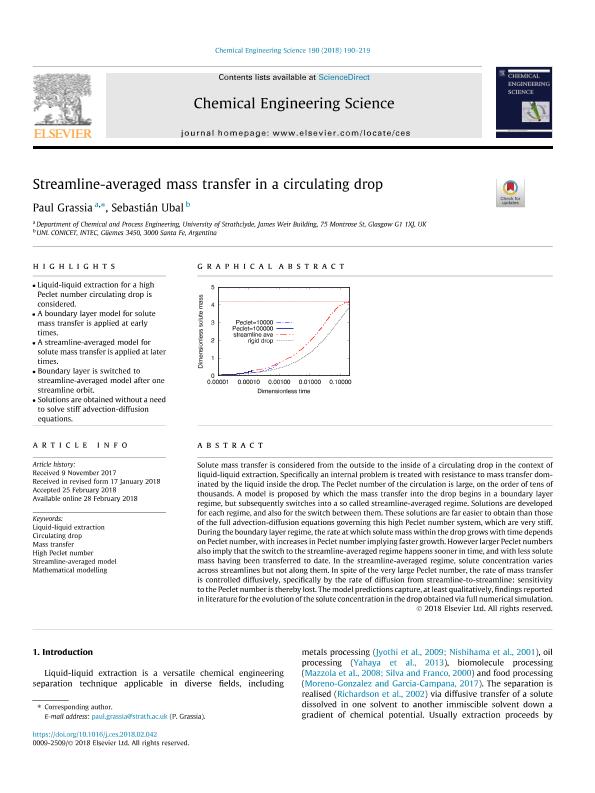Mostrar el registro sencillo del ítem
dc.contributor.author
Grassia, Paul Sebastian

dc.contributor.author
Ubal, Sebastian

dc.date.available
2020-02-02T14:33:06Z
dc.date.issued
2018-11
dc.identifier.citation
Grassia, Paul Sebastian; Ubal, Sebastian; Streamline-averaged mass transfer in a circulating drop; Pergamon-Elsevier Science Ltd; Chemical Engineering Science; 190; 11-2018; 190-219
dc.identifier.issn
0009-2509
dc.identifier.uri
http://hdl.handle.net/11336/96477
dc.description.abstract
Solute mass transfer is considered from the outside to the inside of a circulating drop in the context of liquid-liquid extraction. Specifically an internal problem is treated with resistance to mass transfer dominated by the liquid inside the drop. The Peclet number of the circulation is large, on the order of tens of thousands. A model is proposed by which the mass transfer into the drop begins in a boundary layer regime, but subsequently switches into a so called streamline-averaged regime. Solutions are developed for each regime, and also for the switch between them. These solutions are far easier to obtain than those of the full advection-diffusion equations governing this high Peclet number system, which are very stiff. During the boundary layer regime, the rate at which solute mass within the drop grows with time depends on Peclet number, with increases in Peclet number implying faster growth. However larger Peclet numbers also imply that the switch to the streamline-averaged regime happens sooner in time, and with less solute mass having been transferred to date. In the streamline-averaged regime, solute concentration varies across streamlines but not along them. In spite of the very large Peclet number, the rate of mass transfer is controlled diffusively, specifically by the rate of diffusion from streamline-to-streamline: sensitivity to the Peclet number is thereby lost. The model predictions capture, at least qualitatively, findings reported in literature for the evolution of the solute concentration in the drop obtained via full numerical simulation.
dc.format
application/pdf
dc.language.iso
eng
dc.publisher
Pergamon-Elsevier Science Ltd

dc.rights
info:eu-repo/semantics/openAccess
dc.rights.uri
https://creativecommons.org/licenses/by-nc-sa/2.5/ar/
dc.subject
LIQUID-LIQUID EXTRACTION
dc.subject
CIRCULATING DROP
dc.subject
MASS TRANSFER
dc.subject
HIGH PECLET NUMBER
dc.subject
STREAMLINE-AVERAGED MODEL
dc.subject
MATHEMATICAL MODELLING
dc.subject.classification
Ingeniería de Procesos Químicos

dc.subject.classification
Ingeniería Química

dc.subject.classification
INGENIERÍAS Y TECNOLOGÍAS

dc.title
Streamline-averaged mass transfer in a circulating drop
dc.type
info:eu-repo/semantics/article
dc.type
info:ar-repo/semantics/artículo
dc.type
info:eu-repo/semantics/publishedVersion
dc.date.updated
2020-01-30T21:57:35Z
dc.journal.volume
190
dc.journal.pagination
190-219
dc.journal.pais
Estados Unidos

dc.journal.ciudad
Amsterdam
dc.description.fil
Fil: Grassia, Paul Sebastian. Department Of Chemical And Process Engineering; Reino Unido
dc.description.fil
Fil: Ubal, Sebastian. Consejo Nacional de Investigaciones Científicas y Técnicas. Centro Científico Tecnológico Conicet - Santa Fe. Instituto de Desarrollo Tecnológico para la Industria Química. Universidad Nacional del Litoral. Instituto de Desarrollo Tecnológico para la Industria Química; Argentina
dc.journal.title
Chemical Engineering Science

dc.relation.alternativeid
info:eu-repo/semantics/altIdentifier/doi/http://dx.doi.org/10.1016/j.ces.2018.02.042
Archivos asociados
